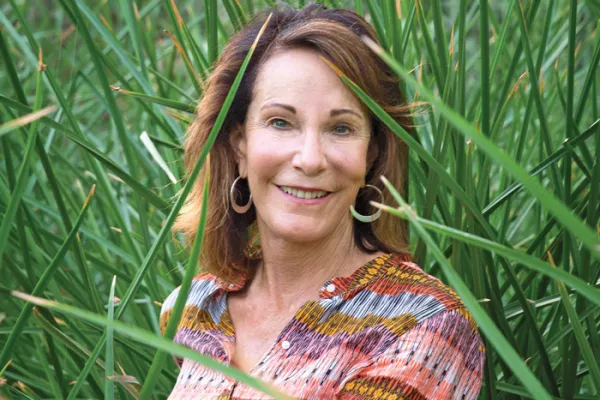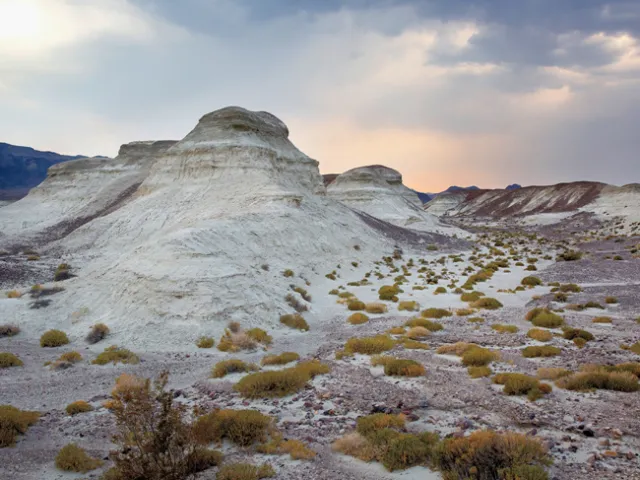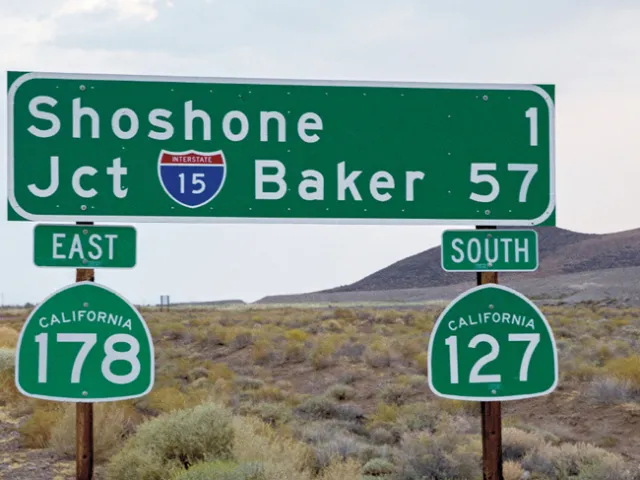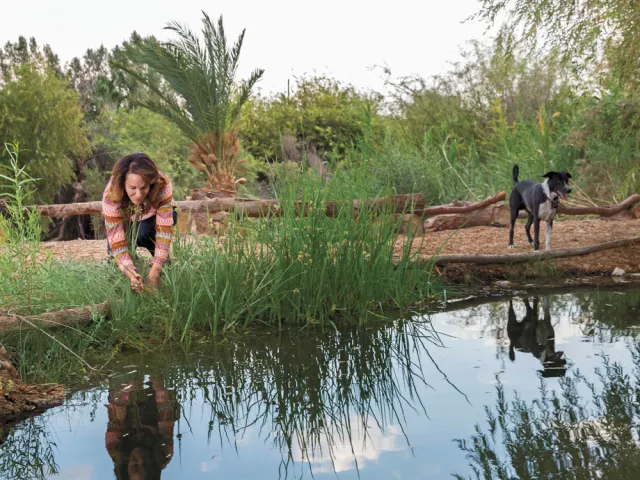Keeper of a Desert Town
Alum News

Published September 9, 2016
In the oasis town of Shoshone, California, a rare superbloom—when winter and spring rains and warmth supercharge the wildflowers—has transformed the valley floor into a field of yellow. “The willows are budding out, there is a fresh smell of spring,” says Susan Sorrells ’68, looking out from her patio at five mountain ranges, a 7,000-foot peak and last spring’s blooming valley.
Back in 1910, when a different kind of yellow—gold, that is—continued to attract miners to these rugged desert hills, Sorrells’ great-grandfather, Ralph Jacobus Fairbanks, founded this town 89 miles west of Las Vegas. Sorrells grew up here, but left to attend Smith and didn’t return until 1980 to care for her mother. Now she owns the land on which the town stands.

Susan Sorrells ’68 is working to reestablish the native bulrushes that once thrived in her oasis town of Shoshone. The surrounding Death Valley region, with its dramatic clay formations, is protected as conservation land.
For Sorrells, owning a town comes with a sense of responsibility—not only to jobs and the town’s economy, but to the endangered plants and creatures that live in this fragile desert environment. Two of those creatures, the Amargosa vole and the Least Bell’s vireo, a songbird, have been on the federal endangered species list since the 1980s. Sorrells and her husband, Robby Haines, both longtime conservationists, believe they have hit on the perfect way to both protect the environment and boost the local economy. In a word: ecotourism.
Their Shoshone Village corporation employs 22 people, including a staff naturalist. They’ve created hiking and birding trails, and they work with the U.S. Fish and Wildlife Service, the California Department of Fish and Wildlife, the Nature Conservancy and university scientists to study and steady the plant and animal populations. Their efforts are attracting visitors from throughout the region and from the 1.5 million people who visit Death Valley each year, creating a bustling economy in what had been a declining former mining town. “Our RV park is packed with people, and we had a 75 percent occupancy rate at our inn last year,” Sorrells says. “Our little town is just humming.”

Shoshone, a former mining town in the desert west of Las Vegas, is the southern gateway to Death Valley National Park.
The couple credits much of their inspiration to a 2009 anniversary trip to Australia, where they witnessed an economy based solidly on ecotourism. “This is viable and sustainable,” Haines concluded at the time. “It’s not just a pipe dream.” Still, it would mean reversing a decline in fortunes for Shoshone, which lost much of its vitality, along with its population (south of 40 at last count), when the mining industry pulled out decades ago.
That earlier population had taken its toll on the desert ecology. Back in the 1930s, the Shoshone pupfish, Cyprinodon nevadensis Shoshone, was declared extinct after its wetland habitat was dried by humans seeking hay for farm animals, Sorrells says. But in 1987, University of Las Vegas biologist Frances R. Taylor was camping near a river outflow and spotted a pupfish. In 2005, conservationists built a series of ponds to catch a spring’s flow; now there are about 5,000 pupfish in this area fed by the Amargosa River.

Sorrells (with her dog, Willie) pulls nonnative plants from a restored pond, a habitat for some 5,000 pupfish, once thought extinct. Another restoration effort is underway to bring back the endangered Amargosa vole.
As Sorrells talks, her Jack Russell terrier wriggles in her arms, eager to get out on the 3-mile hiking trail that she, Haines and their employees built in 2010. “I can be on paths going through the pupfish pond in four minutes,” Sorrells says.
These restoration projects—including one this year to remove nonnative plants and restore the ecosystem of the Amargosa vole—are overseen by university researchers, nonprofit leaders and the Amargosa Conservancy, whose mission is “to protect the land, water and beauty of the Amargosa,” says Sorrells, who co-founded the conservancy in 2002. It turns out that conservation work can be good for business, too, as the conservancy draws more biologists, botanists and archaeologists to join the geologists who have been in the area for decades. Sorrells leads hikes to historical and natural areas in the Amargosa River valley and wants to offer more classes and tours. She also wants to host more conservation events like a recent “bioblitz,” a comprehensive ecological surveying project that was sponsored by the Nature Conservancy.

The Crowbar was built in the 1930s and remains a lively destination, especially in winter.
The area is currently protected as National Conservation Lands, but Sorrells and others are applying for the Amargosa Basin to be declared a national monument. “Death Valley is a rugged area. With monument status, there would be [more] ways to visit without it being dangerous for our visitors,” Sorrells notes.
She is quick to note that work in the Amargosa Valley focuses not on one species, but on species interrelations. “Often, scientists will zero in on one species, but forget that it’s part of the ecosystem,” she says. “So we’re focusing on biodiversity, including people.”
As a conservationist, Sorrells doesn’t work alone. “Our community is active—not just me, or a handful of others, but the whole community,” she says. Being a small settlement within range of Las Vegas has made the residents wary of development. People throughout the county banded together to oppose a massive solar-panel installation that would have included 170,000 mirrors the size of garage doors and two 750-foot-high towers.
“Susan, both as a local business owner and a dedicated conservationist, is a wonderful force for helping preserve the desert history and environment of this remote region of California,” says Jack Prichett, vice president of a California chapter of the Old Spanish Trail Association. “Fifty years from now, if future visitors to Shoshone, California, are still able to enjoy the stark and unspoiled beauty of the desert, they will have her to thank.”
Catherine Arnold is a freelance writer in New York City.
This story appears in the Fall 2016 issue of the Smith Alumnae Quarterly.
Susan Sorrells ’68 Smith ID
House: Morrow
Major: English
Influential Professor: “Vernon Harward, an English professor, took me under his wing. I loved the dedication to knowledge and scientific integrity he imparted, as well as integrity in pursuit of knowledge, and expecting excellence. That expectation of excellence has served me so well.”
Favorite Smith Memory: “I had a bicycle, and I’d ride even in the winter. I just loved riding from the Quad around Paradise Pond, the fragrances of the different seasons, and meeting people. I still have that Raleigh bike.”
Susan Sorrells ’68 turns to ecotourism to protect her village's rugged beauty and keep its economy humming. Photographs by Jessica Scranton